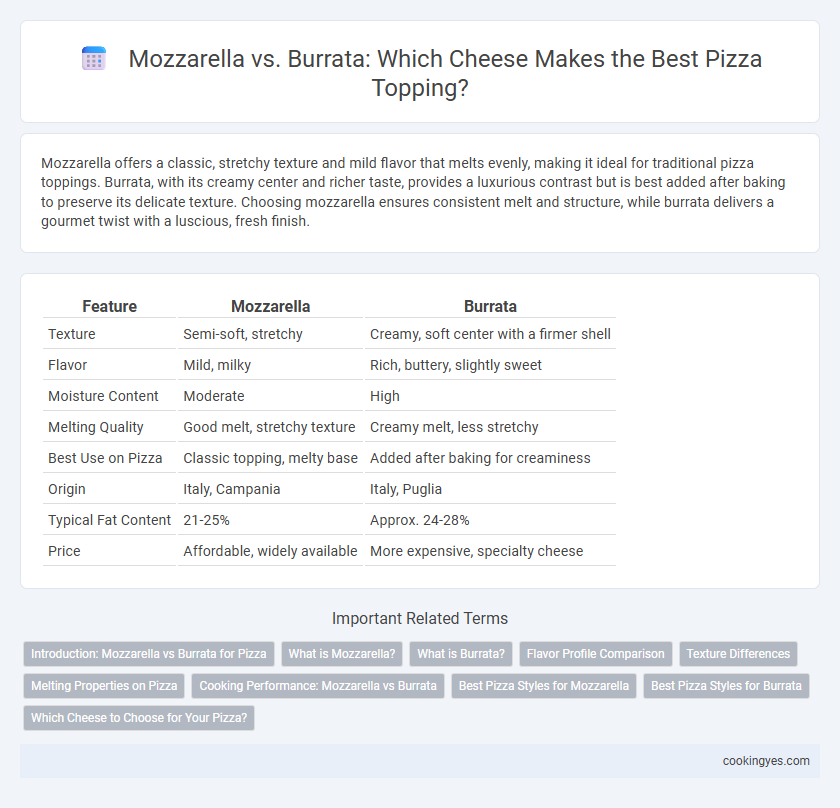Mozzarella offers a classic, stretchy texture and mild flavor that melts evenly, making it ideal for traditional pizza toppings. Burrata, with its creamy center and richer taste, provides a luxurious contrast but is best added after baking to preserve its delicate texture. Choosing mozzarella ensures consistent melt and structure, while burrata delivers a gourmet twist with a luscious, fresh finish.
Table of Comparison
| Feature | Mozzarella | Burrata |
|---|---|---|
| Texture | Semi-soft, stretchy | Creamy, soft center with a firmer shell |
| Flavor | Mild, milky | Rich, buttery, slightly sweet |
| Moisture Content | Moderate | High |
| Melting Quality | Good melt, stretchy texture | Creamy melt, less stretchy |
| Best Use on Pizza | Classic topping, melty base | Added after baking for creaminess |
| Origin | Italy, Campania | Italy, Puglia |
| Typical Fat Content | 21-25% | Approx. 24-28% |
| Price | Affordable, widely available | More expensive, specialty cheese |
Introduction: Mozzarella vs Burrata for Pizza
Mozzarella cheese remains the classic choice for pizza due to its excellent melting properties, mild flavor, and ability to create a gooey, stretchy texture. Burrata offers a rich, creamy alternative with a soft interior that adds luxurious moisture and decadence but melts differently, often best added fresh after baking. Comparing both, mozzarella enhances traditional pizzas with reliable melt and structure, while burrata elevates flavor complexity and creaminess for gourmet toppings.
What is Mozzarella?
Mozzarella is a semi-soft, white cheese made from cow's milk, known for its mild flavor and excellent melting properties, making it a popular choice for pizza toppings. It has a smooth, elastic texture that melts evenly, creating the classic stretchy cheese effect on a hot pizza. Compared to burrata, mozzarella provides a firmer base without the creamy center, offering a more traditional pizza cheese experience.
What is Burrata?
Burrata is a fresh Italian cheese made from mozzarella and cream, characterized by a soft outer shell with a rich, creamy interior. Unlike mozzarella, burrata offers a more decadent texture and flavor that melts into a luscious topping on pizza. Its creamy center enhances the overall taste experience, making it a gourmet alternative to traditional mozzarella.
Flavor Profile Comparison
Mozzarella offers a mild, creamy flavor with a stretchy texture that melts evenly, making it a classic choice for pizza toppings. Burrata combines a mozzarella shell with a soft, buttery interior, delivering a richer, creamier taste that adds a luxurious dimension to pizza. Both cheeses enhance flavor but Burrata provides a more indulgent, decadent experience compared to the straightforward, balanced profile of mozzarella.
Texture Differences
Mozzarella offers a firm, stretchy texture that melts evenly, creating a classic, gooey layer on pizza. Burrata combines a soft outer mozzarella shell with a creamy, almost liquid interior, providing a rich and luxurious mouthfeel. This contrast makes mozzarella ideal for consistent topping coverage, while burrata enhances pizza with bursts of creamy indulgence.
Melting Properties on Pizza
Mozzarella offers excellent melting properties for pizza, creating a smooth, stretchy texture that evenly covers the crust and enhances flavor. Burrata, while creamy and rich, tends to retain its shape and release creamy pockets rather than fully melting, resulting in a more luxurious, less uniform topping. For traditional pizza requiring even melt and stretch, mozzarella remains the preferred choice, whereas burrata adds a decadent, fresh finish when added after baking.
Cooking Performance: Mozzarella vs Burrata
Mozzarella offers superior melting qualities with a stretchy, gooey texture that complements pizza, creating a classic, evenly cooked cheese layer. Burrata, while rich and creamy, tends to release moisture quickly during cooking, which can lead to soggy crusts and less consistent melting. For optimal pizza toppings, mozzarella provides reliable cooking performance and balanced flavor without compromising the dough's texture.
Best Pizza Styles for Mozzarella
Mozzarella is the quintessential cheese for classic pizza styles such as Neapolitan and Margherita, offering a perfect melt and creamy texture that complements tomato sauce and fresh basil. Its low moisture and mild flavor ensure an even, golden crust without sogginess, ideal for high-temperature wood-fired ovens. Compared to Burrata, mozzarella provides better structural integrity, making it the preferred choice for traditional, thin-crust pizzas.
Best Pizza Styles for Burrata
Burrata cheese, with its creamy interior and delicate flavor, excels as a topping on Neapolitan and Margherita pizzas, where its rich texture complements fresh basil and ripe tomatoes. Unlike mozzarella, burrata melts less uniformly, making it ideal for finishing pizzas just before serving to preserve its luxurious creaminess. This cheese enhances artisanal styles focusing on fresh, high-quality ingredients rather than heavily baked toppings.
Which Cheese to Choose for Your Pizza?
Mozzarella cheese remains the top choice for pizza topping due to its excellent meltability, mild flavor, and stretchy texture that complements a variety of toppings. Burrata offers a richer, creamier alternative with its soft outer shell and creamy interior, adding a luxurious touch but melting less evenly compared to mozzarella. For classic pizzas and balanced flavor profiles, mozzarella is ideal, while burrata suits gourmet pizzas where a creamy finish is desired.
Mozzarella vs Burrata for pizza topping Infographic

 cookingyes.com
cookingyes.com